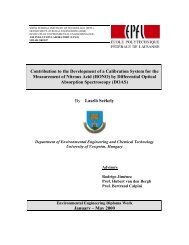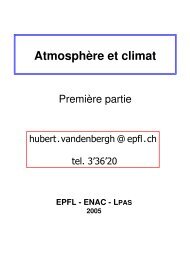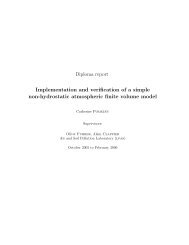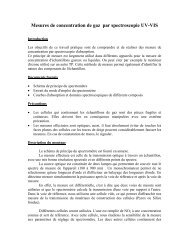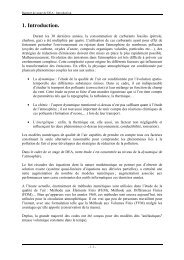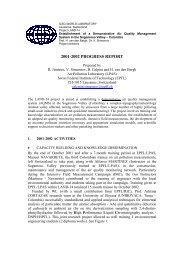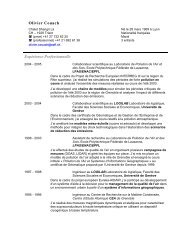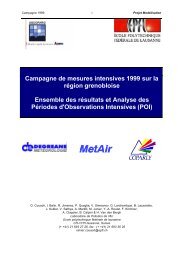A parameterization of heat and momentum fluxes in ... - LPAS - EPFL
A parameterization of heat and momentum fluxes in ... - LPAS - EPFL
A parameterization of heat and momentum fluxes in ... - LPAS - EPFL
You also want an ePaper? Increase the reach of your titles
YUMPU automatically turns print PDFs into web optimized ePapers that Google loves.
The impact <strong>of</strong> the walls is modelled <strong>in</strong> a way similar to what it is done <strong>in</strong> vegetation canopy<br />
models:<br />
3<br />
w drag ort<br />
E = ρC U<br />
⎡ SW<br />
⎢<br />
⎣V<br />
−V<br />
b<br />
⎤<br />
⎥<br />
⎦<br />
In the formulation by Bougeault <strong>and</strong> Lacarrere, the length scales used for the computation <strong>of</strong><br />
the dissipation <strong>and</strong> that for the turbulent diffusion coefficients, are function <strong>of</strong> the TKE value<br />
<strong>in</strong> the po<strong>in</strong>t <strong>and</strong> the pr<strong>of</strong>ile <strong>of</strong> potential temperature.<br />
In the case <strong>of</strong> an urban surface, the presence <strong>of</strong> build<strong>in</strong>gs can <strong>in</strong>duce some circulation <strong>of</strong> a size<br />
comparable with that <strong>of</strong> the roughness element. For this reason, below ro<strong>of</strong> level we added a<br />
second length scale (the roughness element size):<br />
1 1 1<br />
= +<br />
l l hu<br />
B<br />
where hu is the build<strong>in</strong>g’s height <strong>and</strong> l B<br />
is the length scale computed with the orig<strong>in</strong>al<br />
formulation.<br />
Vertical pr<strong>of</strong>iles <strong>of</strong> TKE normalised by the square root <strong>of</strong> the Reynolds Stress at the ro<strong>of</strong><br />
height are shown <strong>in</strong> Fig. 6.<br />
Figure 6: Vertical pr<strong>of</strong>ile <strong>of</strong> the ratio between the turbulent k<strong>in</strong>etic energy <strong>and</strong> the square root <strong>of</strong> the Reynolds<br />
Stress computed by the model <strong>in</strong> the centre <strong>of</strong> the urban area at different time <strong>of</strong> the day.<br />
Those values are consistent with the measurements <strong>of</strong> Rotach (1993) around ro<strong>of</strong> height <strong>and</strong><br />
with that <strong>of</strong> Feigenw<strong>in</strong>ter et al. at 2-3 times the build<strong>in</strong>g height.<br />
As for <strong>momentum</strong>, also for TKE the most active surface is the walls.<br />
4. Conclusions<br />
A parameterisation for <strong>heat</strong> <strong>and</strong> <strong>momentum</strong> <strong>fluxes</strong> for mesoscale models <strong>in</strong> urban areas is<br />
presented. The formulation takes <strong>in</strong>to account separately the impact <strong>of</strong> the three active<br />
surfaces <strong>of</strong> the roughness element: wall, street <strong>and</strong> ro<strong>of</strong>. The modifications were <strong>in</strong>troduced <strong>in</strong><br />
a mesoscale model <strong>and</strong> tested <strong>in</strong> a simple 2D case. A comparison with series <strong>of</strong> field



